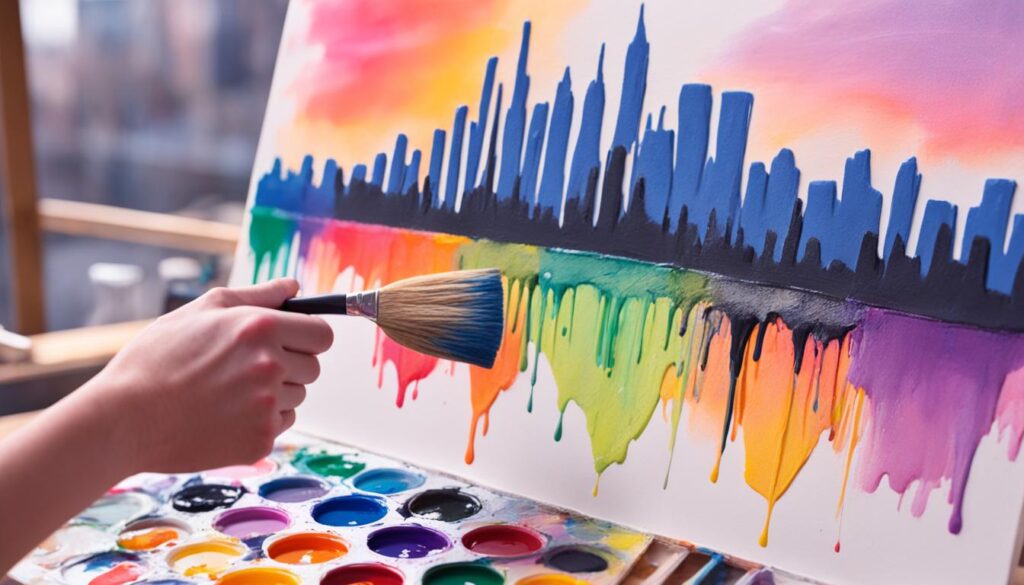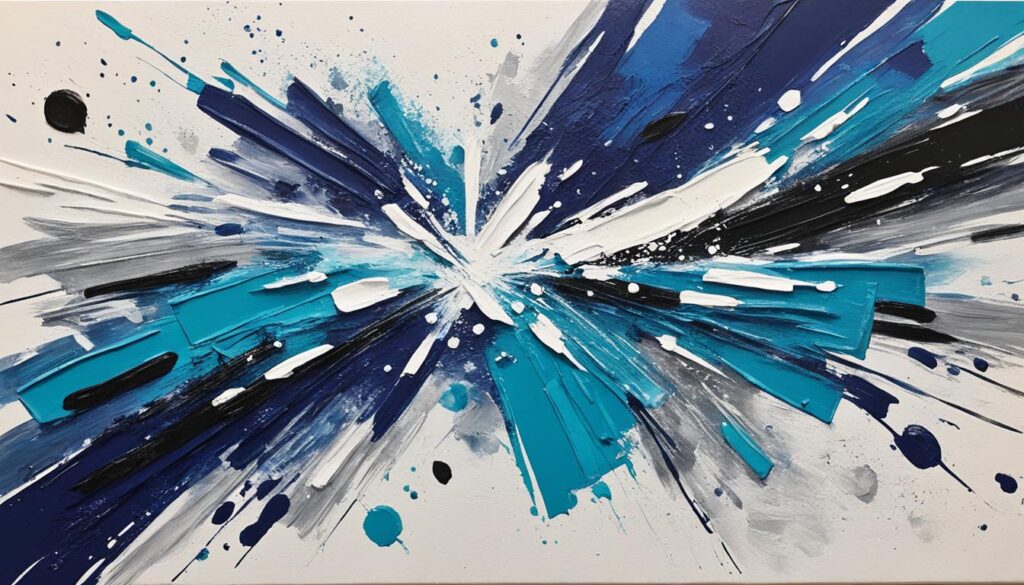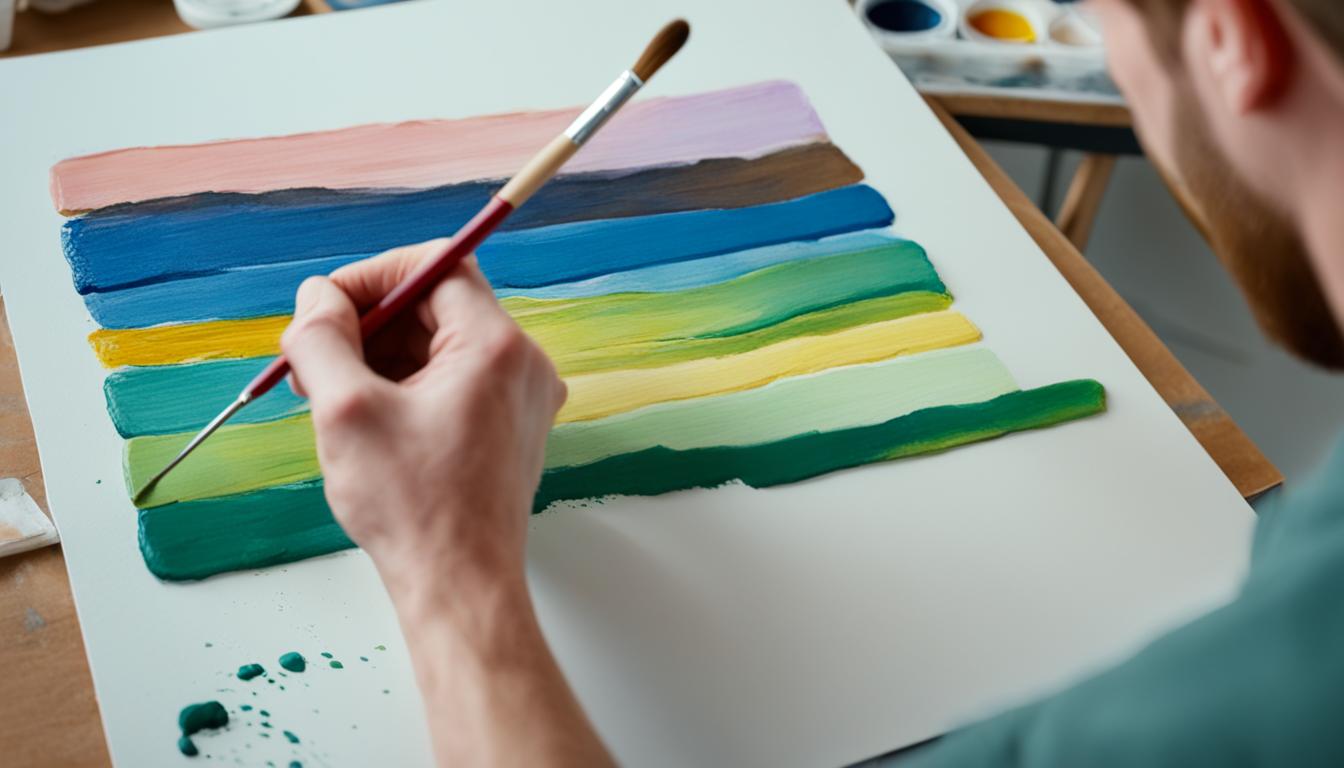This post contains affiliate links.
Have you ever felt that flutter of excitement when you gaze at a beautifully painted canvas? The vibrant colors, the brushstrokes that seem to dance across the surface, the way the painting brings a sense of life and expression to the room. It’s a powerful feeling, one that connects us to our own creativity and the beauty of the world around us.
If you’ve ever yearned to create your own works of art but weren’t sure where to start, then this beginner’s guide to acrylic painting is for you. Step into a world of color and possibilities as we take you on a journey to unlock your inner artist. Whether you’re an absolute beginner or have some experience with other mediums, acrylic painting offers a versatile and accessible entry point into the world of art.
In this guide, we’ll provide you with step-by-step tutorials and beginner-friendly lessons that will help you dive into the world of acrylic painting. From mastering basic techniques to exploring more advanced methods, we’ll cover everything you need to know to create your own beautiful acrylic masterpieces.
So, grab your paintbrushes and let your imagination soar as we embark on this artistic adventure together. Whether you dream of painting breathtaking landscapes, capturing the essence of a loved one in a portrait, or simply expressing your innermost thoughts and emotions on canvas, acrylic painting is a medium that will empower and inspire you.
Acrylic Painting Guide Key Takeaways:
- Acrylic painting is a versatile and accessible medium for beginners.
- With step-by-step tutorials and beginner-friendly lessons, you can learn and master acrylic painting techniques.
- Acrylic paints dry quickly, allowing for easy layering and experimentation.
- Choosing the right materials, such as good-quality acrylic paints and brushes, is essential for achieving better results in your artwork.
- By practicing different techniques and expressing your own style, you can unleash your inner artist and create stunning acrylic paintings.
What Are Acrylic Paints?
Acrylic paint is the magical potion that brings your artistic visions to life! Whether you’re a beginner or a seasoned artist, this versatile medium is perfect for expressing your creativity on canvas. So, let’s dive into the world of acrylic paints and discover why they are a must-have for every aspiring artist.
Acrylic paint is a water-based paint that offers a myriad of advantages. Unlike oil paints, which can be a bit messy and require solvents for thinning and cleaning, acrylic paints are much more forgiving and convenient to work with. You’ll be amazed at the ease with which these paints can be thinned or cleaned up using just water.
One of the biggest perks of acrylic paints for beginners is their fast drying time. Unlike oil paints that take days or even weeks to dry, acrylic paints dry quickly, allowing you to add new layers or make changes without having to wait for eternity. This speedy drying time is especially useful when you’re bursting with creativity and can’t wait to see your masterpiece come to life.
“Acrylic paints are like little magical elves, turning your artistic visions into reality at the speed of light.”
But wait, there’s more! Acrylic paints are incredibly flexible and can be easily layered and corrected. If you make a mistake, don’t fret! These paints have got your back. Simply layer another color over the area you want to correct, and voila! No one will ever know you had a little artistic detour.
Now that you’re acquainted with the wonders of acrylic paints, it’s time to grab your paintbrush and unleash your inner Van Gogh. The possibilities are endless, and the world is your canvas. So go ahead, paint your heart out!
Materials You’ll Need and the Best Acrylic Paint Brands
Ready to dive into the world of acrylic painting? Great! To get started, you’ll need a few essential materials. Having the right tools can make all the difference in your painting experience, helping you create stunning works of art. Here’s a list of what you’ll need:
- Good-quality acrylic paints: Choose artist-grade acrylic paints for vibrant colors and better coverage. Recommended brands include:
| Brand | Description |
|---|---|
| Winsor & Newton | A popular choice among artists, known for their high-quality pigments and color range. |
| Liquitex | Offers a wide selection of acrylic paints, ranging from heavy body to fluid consistency. |
| M. Graham | Known for their vibrant, lightfast colors that retain their brilliance over time. |
| Blick Studio | Affordable yet reliable, these paints offer good color intensity and versatility. |
| Arteza | Affordable and beginner-friendly, with a wide range of colors and sets to choose from. |
| Artist’s Loft | Easy on the budget and readily available, making it a popular choice for beginners. |
- Paintbrushes: Invest in a variety of brushes suitable for acrylic painting, such as flat, round, and filbert brushes.
- Canvas or canvas board: Choose the surface that suits your preferences, whether it’s stretched canvas or canvas boards.
- Palette and palette knife: Use a palette to mix your colors and a palette knife to create texture or apply paint.
- Water cup: Keep a cup of water nearby for rinsing your brushes.
- Scrap paper and paper towels: These are handy for blotting excess paint or testing colors before applying them to your canvas.
By ensuring you have these must-have materials, you’ll have a smooth painting process and be well-equipped for your beginner-friendly acrylic painting tutorials. So, gather your supplies, prepare your creative space, and let your artistic journey begin!

Painting with Passion
“The only way to do great work is to love what you do.” – Steve Jobs
9 Handy Tips for Using Acrylic Paint
Acrylic painting is an exciting journey filled with endless possibilities. To help you navigate the world of acrylic painting, here are 9 handy tips that will enhance your skills and bring your artwork to life.
- Start with a clean canvas: Before you begin painting, make sure your canvas is clean and free from any dust or debris. This will ensure a smooth and even surface for your paint to adhere to.
- Use a wet palette: Keep your acrylic paint from drying out too quickly by using a wet palette. This will prevent your paint from becoming too thick and allow you to easily mix colors.
- Experiment with different brushes: Try using brushes of various shapes and sizes to achieve different effects in your painting. Flat brushes are great for large areas, while round brushes are ideal for adding details.
- Layer your paint: Acrylic paint dries quickly, which allows you to layer different colors on top of each other. Experiment with layering to create depth and texture in your artwork.
- Add water for transparency: If you want to achieve a more transparent effect, you can add water to your acrylic paint. This will allow the underlying layers to show through.
- Add gel medium for texture: To create texture in your painting, mix gel medium with your acrylic paint. This will give your artwork added dimension and visual interest.
- Blend colors on the canvas: Instead of mixing colors on your palette, try blending them directly on the canvas. This will create more vibrant and dynamic colors in your painting.
- Use quick strokes: Acrylic paint dries quickly, so use quick strokes to apply your paint. This will help prevent your brush strokes from drying before you’re done.
- Experiment and have fun: The most important tip is to experiment and have fun with your acrylic painting. Don’t be afraid to try new techniques and push your boundaries as an artist.
By following these tips, you’ll have a solid foundation for your acrylic painting journey. Remember to practice, be patient, and enjoy the process. Happy painting!
Tips and Tricks for Acrylic Painting
Now that you have learned the basics of acrylic painting, let’s dive into some additional tips and tricks that will take your artwork to the next level. These simple techniques are perfect for beginners looking to enhance their skills and create stunning paintings.
1. Experiment with Different Brushes
Don’t be afraid to explore various brush types and sizes. Different brushes can create unique textures and effects in your paintings. Try using a flat brush for broad strokes and a round brush for fine details.
2. Add Texture with Palette Knives
Palette knives are not just for mixing paint. They can also be used to add texture and create interesting effects in your paintings. Use the edge of the palette knife to scrape or drag the paint across the canvas, adding depth and dimension to your artwork.
3. Play with Colors
Acrylic paints are known for their vibrant colors, so don’t be afraid to experiment and mix different hues. Create a color palette that reflects your mood or the atmosphere you want to convey in your painting. Remember, the possibilities are endless!
4. Use Masking Tape
If you want clean, crisp edges in your painting, use masking tape to create straight lines or block off areas. Apply the tape to the canvas before painting and remove it once the paint is dry. This technique is especially useful for creating geometric shapes or adding details to architecture.

5. Try Dry Brushing
Dry brushing is a technique where you use a dry brush with a small amount of paint to create a rough, textured effect. This technique is perfect for adding highlights or fine details to your artwork. Simply dip your brush in the paint, remove most of the paint on a paper towel, and lightly drag the brush over the canvas.
6. Create Depth with Layering
Acrylic paints dry quickly, allowing you to layer colors and build depth in your paintings. Start with lighter colors as the base and gradually add darker shades on top. This layering technique adds dimension and creates a sense of depth in your artwork.
7. Use a Spray Bottle for Blending
If you want to create soft, blended colors in your painting, try misting the canvas with water using a spray bottle. The water will reactivate the paint, making it easier to blend and create smooth transitions between colors.
8. Don’t Overblend
While blending can create beautiful effects, be careful not to overblend your colors. Overblending can result in muddy colors and a loss of contrast. Instead, embrace the texture and brushstrokes in your painting to create more dynamic and interesting artwork.
9. Take Breaks and Step Back
Painting can be an immersive process, but it’s important to take breaks and step back from your artwork. Distance yourself from the canvas to get a fresh perspective and evaluate your painting from different angles. This will help you identify areas that may need adjustment or improvement.
Remember, painting is a journey of self-expression and exploration. Don’t be afraid to make mistakes and experiment with different techniques. With practice and patience, you’ll develop your own unique style and create amazing acrylic paintings. Happy painting!
14 Acrylic Painting Techniques Every Beginner Can Try
Ready to take your acrylic painting skills to the next level? Here are 14 fantastic techniques that are perfect for beginners like you:
- Wet-on-Wet: Apply wet paint onto a wet surface to create beautiful, blended effects.
- Dry Brush: Use a dry brush with a small amount of paint for textured, brushstroke-heavy effects.
- Splatter: Load your brush with paint, then tap it against another brush to create controlled or random splatters.
- Scumbling: Apply a thin layer of lighter paint over a darker color to create a soft, hazy effect.
- Glazing: Layer transparent colors over a dry base coat to create depth and luminosity.
- Impasto: Apply thick layers of paint with a palette knife to create a textured, three-dimensional effect.
- Stippling: Use small, dot-like brushstrokes to create texture and patterns.
- Sgraffito: Scratch through a layer of wet paint to reveal the colors underneath.
- Blending: Use a clean, damp brush to blend two or more colors together seamlessly.
- Masking: Apply masking tape or a masking medium to create crisp, clean edges in your painting.
- Dry Brush Stamping: Load a dry brush with paint, then tamp it onto the surface for a textured stamping effect.
- Color Blocking: Divide your canvas into sections and apply bold colors in each section for a graphic, modern look.
- Gradients: Blend two or more colors together to create a smooth, gradual transition of hues.
- Monochrome: Explore the power of a single color by using different shades and tones for a cohesive, harmonious look.
Experiment with these techniques and have fun exploring the endless possibilities of acrylic painting. Remember, practice makes perfect, so don’t be afraid to try new things and make mistakes along the way. Happy painting!
Expert Tip:
“Don’t be afraid to mix and match these techniques to create your own unique style. The beauty of acrylic painting lies in its versatility, so let your creativity flow and have fun!”

That’s not all! In the next section, we’ll show you how to apply these acrylic painting techniques with Painting to Gogh tutorials, bringing your artwork to life.
Try These Acrylic Painting Techniques with Your Next Painting to Gogh Tutorial
Now that you’ve learned various acrylic painting techniques, why not try them out with a Painting to Gogh tutorial? Painting to Gogh offers step-by-step painting tutorials that are beginner-friendly and delivered right to your doorstep. With their artist-led video instructions, you can practice and perfect your acrylic painting skills while creating beautiful artwork.
Whether you’re interested in landscapes, still life, or abstract art, Painting to Gogh has a tutorial that will inspire and guide you. Their tutorials are designed to be accessible to beginners, allowing you to explore different acrylic painting techniques at your own pace.
By following these tutorials, you can learn new skills, gain confidence in your abilities, and create stunning paintings. Painting to Gogh provides a convenient and affordable way to improve your acrylic painting skills from the comfort of your own home.

So why wait? Grab your brushes and unleash your creativity with a Painting to Gogh tutorial. With their expert guidance and your newfound skills, you’ll be amazed at what you can achieve.
Conclusion
Ready to unleash your inner artist? Acrylic painting is a rewarding and creative hobby that offers endless possibilities for beginners and experienced artists alike. With a little practice and the right guidance, you can create stunning masterpieces on canvas.
Start your acrylic painting journey by following step-by-step tutorials designed specifically for beginners. These tutorials will walk you through each stage, from selecting the right materials to mastering various techniques. Embrace experimentation and don’t be afraid to make mistakes. It’s through these mistakes that you’ll discover your own unique style and artistic voice.
Remember, becoming skilled at acrylic painting is a gradual process. The more you practice, the more confident you’ll become. So, grab your paintbrushes, let your creativity flow, and embark on a colorful adventure. Explore the vibrant world of acrylic paint and watch as your skills evolve. Get ready to wow yourself and others with your beautiful creations!
FAQ
What are some easy acrylic painting tutorials for beginners?
We provide step-by-step acrylic painting tutorials for beginners, covering a wide range of subjects from landscapes to abstract art. These tutorials are designed to be beginner-friendly and help you learn and master the art of acrylic painting.
What materials do I need to get started with acrylic painting?
To get started with acrylic painting, you will need good-quality acrylic paints, paintbrushes, canvas or canvas board, a palette, palette knife, water cup, scrap paper, and paper towels. Choosing artist-grade acrylic paints is recommended for better color coverage and longevity.
What are some popular brands for acrylic paints?
Some popular brands for acrylic paints include Winsor & Newton, Liquitex, M. Graham, Blick Studio, Arteza, and Artist’s Loft. These brands offer a wide range of colors and are known for their quality and affordability.
What are some handy tips for using acrylic paint?
Here are 9 handy tips for using acrylic paint: 1. Keep your brushes clean by rinsing them in water between color changes. 2. Use a palette knife to mix colors and create interesting textures. 3. Start with thin layers and gradually build up the paint. 4. Use a spray bottle to keep your acrylic paint from drying too quickly on the palette. 5. Use a wet palette to keep your acrylic paint workable for longer periods. 6. Experiment with different acrylic mediums to achieve different effects. 7. Use masking tape or a palette knife to create clean edges in your paintings. 8. Add a varnish to protect and enhance the finished painting. 9. Have fun and embrace the versatility of acrylic paint!
Any additional tips and tricks for acrylic painting?
Here are some additional tips and tricks for acrylic painting: 1. Use a hairdryer to speed up the drying process between layers. 2. Create texture by adding sand or other materials to your paint. 3. Use a dry brush technique to create highlights and textures. 4. Explore different brushes and brush strokes to add variety to your paintings. 5. Experiment with different surfaces such as wood or cardboard. 6. Use a limited color palette to create harmony in your paintings. 7. Practice blending colors to achieve smooth transitions. 8. Use a ruler or masking tape to create straight lines. 9. Step back from your painting regularly to see it from a distance and make adjustments.
What are some acrylic painting techniques that are perfect for beginners?
Here are 14 acrylic painting techniques that are perfect for beginners: 1. Wash and glaze technique. 2. Dry brushing. 3. Sgraffito. 4. Impasto. 5. Stippling. 6. Splattering. 7. Gradients and ombre. 8. Color blocking. 9. Blending and layering. 10. Sponging. 11. Masking. 12. Pouring and dripping. 13. Palette knife painting. 14. Monochromatic painting.
Where can I find beginner-friendly acrylic painting tutorials?
Painting to Gogh offers step-by-step painting tutorials that are beginner-friendly and delivered right to your doorstep. Their artist-led video instructions will help you practice and perfect your acrylic painting skills while creating beautiful artwork. Whether you’re interested in landscapes, still life, or abstract art, Painting to Gogh has a tutorial that will inspire and guide you.
Is acrylic painting suitable for beginners?
Yes, acrylic painting is a rewarding and creative hobby that can be enjoyed by beginners and experienced artists alike. With the right materials, techniques, and practice, anyone can learn to create stunning acrylic paintings. By following step-by-step tutorials, experimenting with different techniques, and expressing your own unique style, you can unleash your inner artist and create masterpieces on canvas.
Source Links
- https://www.paintingtogogh.com/blogs/news/how-to-use-acrylic-paint
- https://arteza.com/blogs/articles/21-acrylic-painting-tips-for-beginners
- https://www.paintingtogogh.com/blogs/news/acrylic-painting-techniques
This post contains affiliate links.

